Intel Unveils New Low-Cost PC Platform: Apollo Lake with 14nm Goldmont Cores
by Anton Shilov on April 15, 2016 6:00 PM EST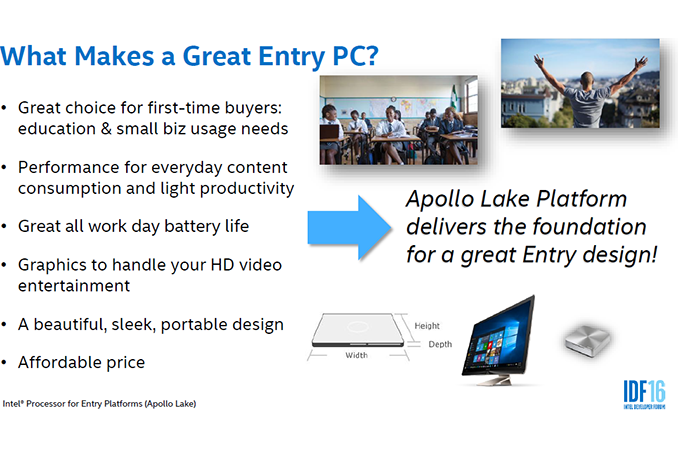
This week, at IDF Shenzhen, Intel has formally introduced its Apollo Lake platform for the next generation of Atom-based notebook SoCs. The platform will feature a new x86 microarchitecture as well as a new-generation graphics core for increased performance. Intel’s Apollo Lake is aimed at affordable all-in-ones, miniature PCs, hybrid devices, notebooks and tablet PCs in the second half of this year.
The Apollo Lake system-on-chips for PCs are based on the new Atom-based x86 microarchitecture, named Goldmont, as well as a new graphics core that features Intel’s ninth-generation architecture (Gen9) which is currently used in Skylake processors. Intel claims that due to microarchitectural enhancements the new SoCs will be faster in general-purpose tasks, but at this stage Intel has not quantified the improvements. The new graphics core is listed as being more powerful (most likely due to both better architecture and a higher count of execution units), but will also integrate more codecs, enabling hardware-accelerated playback of 4K video from hardware decoding of HEVC and VP9 codecs. The SoCs will support dual-channel DDR4, DDR3L and LPDDR3/4 memory, which will help PC makers to choose DRAM based on performance and costs. As for storage, the Apollo Lake will support traditional SATA drives, PCIe x4 drives and eMMC 5.0 options to appeal to all types of form-factors. When it comes to I/O, Intel proposes to use USB Type-C along with wireless technologies with Apollo Lake-powered systems.
| Comparison of Intel's Entry-Level PC and Tablet Platforms | ||||||
| Bay Trail | Braswell | Cherry Trail | Apollo Lake | |||
| Microarchitecture | Silvermont | Airmont | Airmont | Goldmont | ||
| SoC Code-Name | Valleyview | Braswell | Cherryview | unknown | ||
| Core Count | Up to 4 | |||||
| Graphics Architecture | Gen 7 | Gen8 | Gen8 | Gen9 | ||
| EU Count | unknown | 16 | 12/16 | unknown (24?) | ||
| Multimedia Codecs | MPEG-2 MPEG-4 AVC VC-1 WMV9 HEVC (software only) VP9 (software only) |
MPEG-2 MPEG-4 AVC VC-1 WMV9 HEVC (8-bit software/hybrid) VP9 (software/hybrid) |
MPEG-2 MPEG-4 AVC VC-1 WMV9 HEVC VP9 |
|||
| Process Technology | 22 nm | 14 nm | 14 nm | 14 nm | ||
| Launch | Q1 2014 | H1 2015 | 2015 | H2 2016 | ||
From the IDF presentation, Intel shares only a few brief details regarding its new Apollo Lake design platform, but does not disclose exact specifications or performance numbers. At this point, based on 14nm Airmont designs, it is pretty safe to assume that the new SoCs will contain up to four Goldmont cores in consumer devices but perhaps 8+ in communications and embedded systems. Intel has not specified the TDP of its new processors but claims that power management features of the platform will help it to improve battery life compared to previous-gen systems (which might point to a Speed Shift like arrangement similar to what we see on Skylake, perhaps). While Intel does not reveal specifics of its own SoCs, the company shares its vision for the upcoming PCs powered by the Apollo Lake platform.
Firstly, Intel believes that the upcoming affordable PCs, whether these are all-in-one desktops, miniature systems, 2-in-1 hybrids, laptops or tablets, should be very thin. According to their market research, this will make the devices more attractive to the buyer, which is important. To make systems thinner, Intel traditionally proposes to use either M.2 or solder-down eMMC solid-state storage options instead of 2.5” HDDs/SSDs. In addition, the company believes that it makes sense to use solder-down Wi-Fi, instead of using a separate module. Intel seems to be especially proud with the compactness of the Apollo Lake SoC (as well as other core components) and thus the whole platform, which is another factor that will help to make upcoming systems thinner. For the first time in recent years, Intel also proposes the use of smaller batteries, but devices can maintain long battery life by cutting the power consumption of the entire platform. While in many cases reduction of battery size makes sense, it should be noted that high-resolution displays typically consume a lot of energy, which is why it is hard to reduce the size of batteries, but maintain the visual experience along with a long battery life.
Secondly, PCs based on the Apollo Lake should be very affordable, which is why Intel’s reference core components design can be used for different form-factors (AiO and mobile). Additionally, the company reveals a number of BOM (bill of materials) savings opportunities, which are a result of higher level of SoC integration as well as a recommended choice of components. In the slide above, using all the savings can make a difference in BOM for between $5.55 and $7.35, which could mean double memory or a better display for the same price for the new generation.
Intel’s reference design for Apollo Lake-based PCs seems to be a tablet/2-in-1 hybrid system with an 11.6” full-HD (1920x1080) 10-point multi-touch display, 4 GB of LPDDR3-1866 memory, 64 GB M.2 SATA3 SSD or 32 GB eMMC storage, an M.2 wireless module supporting 802.11ac, an optional M.2 LTE modem, an integrated USB 2 camera, a host of sensors (accelerometer, ambient light, proximity detection, and magnetic switching) as well as a USB Type-C connector supporting USB power delivery and alternate modes. Such reference design can power not only mobile, but also Aan IO and even small form-factor desktop PCs. Still, given the fact that we are talking about low-cost systems, do not expect retail computers to feature multiple storage devices and LTE modems. However, PC makers may opt for more advanced displays as well as better integrated cameras, or an SI might plump for a half-price 'Macbook-like' device design using Type-C, albeit on the Atom microarchitecture. This is Intel's vision forthe next generation of Chromebooks: the 'cloud book' market.
PCs based on Intel’s Apollo Lake platforms will emerge in the second half of the year and will carry Celeron and Pentium-branded processors. At present, entry-level notebooks (which Intel calls Cloudbooks) offer 2 GB of memory, 32 GB of storage, 8+ hours of battery life and ~18mm thick designs. With Apollo Lake, OEMs should be able to increase the amount of RAM and/or storage capacity, make systems generally thinner, but maintain their $169 - $269 price-points. Intel also believes that its Apollo Lake presents great opportunities to build 2-in-1 hybrid PCs (convertibles) and capitalize on higher margins of such systems.
Traditionally, Intel discusses options and its vision, but not actual PCs, at its IDF trade-shows. It remains to be seen whether PC makers decide to build low-cost convertibles or ultra-thin notebook designs, or will stick to more traditional clamshell notebooks. In fact, we will learn more about BTS (back-to-school) plans of major PC OEMs regarding Apollo Lake at the upcoming Computex trade-show in early June. There's also IDF San Francisco in August where Intel may open some lids on how the new Goldmont core differs from Airmont.
Source: Intel


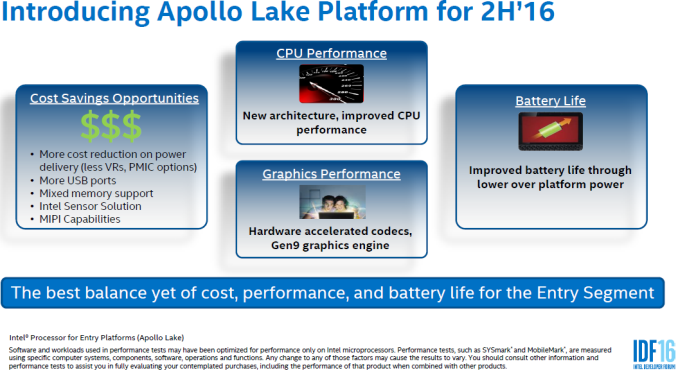
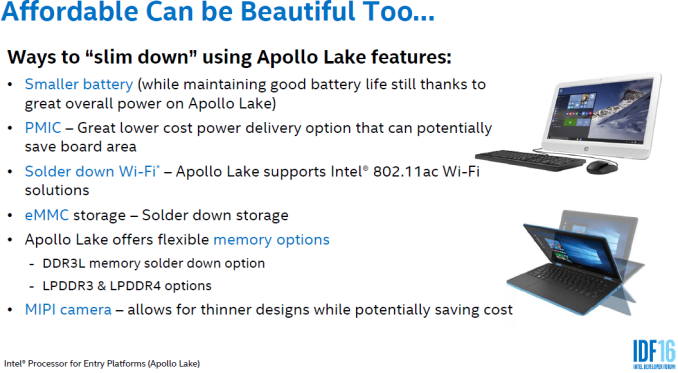
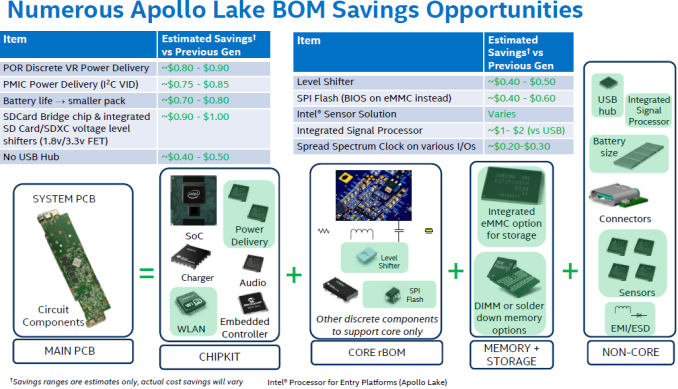
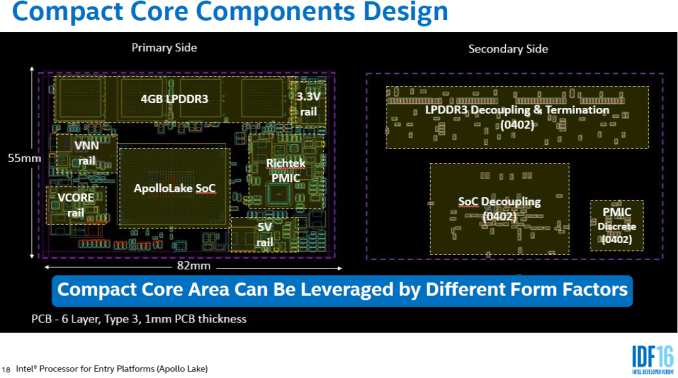

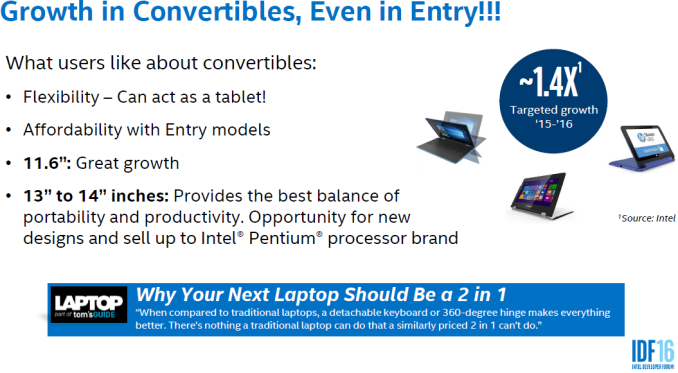














95 Comments
View All Comments
name99 - Friday, April 15, 2016 - link
Cloudbooks? Seriously? And you think those "offered with a cloud service of some kind" crapware offerings are a PLUS?Intel is so utterly lost here, with this desperate hope that cloudbooks will be what ultrabooks weren't. I guess the thinking goes "well, with ultrabooks we tried to sell to the high end, but the OEMs sabotaged us at every step; so this round let's just skip the BS and admit we're peddling cheap crap in a race to the bottom".
Of course this is all in reaction to:
http://www.macrumors.com/2016/04/11/gartner-idc-pc...
(TL;DR - worldwide PC shipments down 9.6% over the last year --- AGAIN... Sixth consecutive of PC shipments, and lower shipments than in 2007...)
JoeyJoJo123 - Friday, April 15, 2016 - link
You can blame the lack of big performance gains year-over-year in processors for that.PCs sold like hotcakes back when big performance gains were to be had over last year's model. In a way, this is kind of a good thing; it means that there's less e-waste going around and people are actually holding onto PCs for a longer period of time, rather than chunking them out the door.
Thatguy97 - Friday, April 15, 2016 - link
Yeah but on the other hand the cpu side of things now is boring as all hellMrPoletski - Monday, April 18, 2016 - link
Well hopefully Zen will change all that, even if it doesn't kick intels ass, it'll hopefully make them sit up straight, do up their tie and stop having that triple vodka during their lunch break. Then we might see an intel with it's pants down again. I really hope zen vs skylake ends up being like the athlon XP vs pentium 4 days. Then we will see the new core2 from intel rawr.duploxxx - Monday, April 18, 2016 - link
the issue is that you expect that current slow performance is due to lack of CPU power, which is not the case :)run your system with i3 or i7 with equal memory and storage system for general tasks it will still be crappy MS to get your pants down..... even Intel releases i9 :) still crappy SW based on the initial fat slow dog called x86.
mapesdhs - Wednesday, April 20, 2016 - link
Indeed, just wasted an hour trying to fix weird Win7 driver issues...gamerk2 - Monday, April 18, 2016 - link
The issue is that the tasks we care about (games) are almost entirely GPU limited, to the point where the CPU really doesn't matter to us anymore.Throw in the fact that for everyone else a Pentium class CPU is more then enough, and you get general disinterest about CPU improvements.
mapesdhs - Wednesday, April 20, 2016 - link
Yup, a mere G3258 in an HTPC is surprisingly strong. Paired with a 750 Ti, pretty good for most stuff, handles Google Earth nicely, totally quiet (ASUS Z97I-Plus, SanDisk X300 256GB).name99 - Friday, April 15, 2016 - link
That's not exactly true. Yes, the Western PC market is saturated. But phones and tablets, and traditional PCs in non-Western markets, were Intel's to lose. And lose them they did...It was Intel's choice to prioritize the x86 ISA over their other advantages (like circuit and process prowess), with all that implied for additional complexity and cost over the ARM alternative; and the business consequences that implied (ie never letting Atom get too good compared to the expensive CPUs). The consequences were easily predictable at the time, and WERE predicted (by me, among others); but that's what happens when you're trapped in a bubble where everyone tells you the x86 ISA is so unbelievably fantastic that no-one would ever want to use anything else.
And it's not even like Intel had no warning. They freaking LIVED through Apple switching from PPC to x86 because x86 provided better low-power chips, and they TOLD Intel that they wanted even lower power chips for mobility...
Reflex - Friday, April 15, 2016 - link
You are partly right and partly wrong. You are correct, Intel hamstrung the Atom, a CPU introduced in 2008 but not really usable until about three years ago due to lack of investment. That was a huge miss. Even now they have yet to integrate it with a proper LTE modem and other features common to ARM designs. Its a huge mistake.You are wrong about them prioritizing x86 and that being a mistake. The instruction set is not relevant. There is nothing inherently better about the ARM ISA vs x86, and as ARM has grown in complexity its power and performance profile has started to become very similar to x86. Intel staying with the ISA they have invested decades into optimizing is not a mistake, its leveraging already expended R&D.
The mistake, as I stated before, was insisting on product segmentation to the detriment of their truly low power designs.